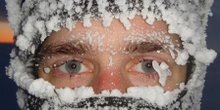Winter Trip
Emperor Penguins

As winter becomes a fleeting memory, there is plenty to be done outside in respect of both work and play. The impetus to write a regular blog also evaporates as other attractions become more enticing- such as skiing or making the best use of the weather to get work done, whatever time of day.
Chris Walking to Work

The weather had to improve, for the last month or so has been plagued by high winds, particularly unfortunate as the bulk of the post-winter trips have taken place over the course of the month. My trip, taking the exciting name and slightly inappropriate name of Sledge Hotel, was due out in late September but our departure was curtailed for four days by poor contrast and high winds. (Each trip takes a sledge name with a radio call sign, invariably unofficial versions of the call sign are thought up but this year none of them have really stuck).
Nansen Sledge at Windy
A fully laden 'half-unit'

However, we finally got underway though slightly depleted, as a trio rather than the usual four, which precluded any time in tents. So, led by Sune, who as Field GA runs all the trips, Chris and I headed the short 18 km or so to the caboose at Windy Bay, where the main attraction is the penguin colony.
Lots of Penguins
Though we could have camped elsewhere on the Brunt ice shelf if we had tents, the advantage of the caboose, apart from being able to stand up in it, is a powerful Reflex stove in the corner, which keeps the place well above the external -30°C.
Inside Windy Caboose

With four days lost on base to poor weather, the last five were almost a further white-out but were saved by the last day when we had superb weather. That said, on each day the contrast improved enough for us to escape for a few hours and explore the cliffs and the area around the caboose. With the wind rarely below the acceptable 15 knots for venturing onto sea ice, we still managed to watch the sun set from the cliffs overlooking the main colony.
Roped Up as an Alpine Three

The contrast is vital, not only to be able to see the cliff edge but any possible crevasses or other hazards. Poor weather also prevented as from travelling across to the Rumples, where the shelf is grounded on a raised area of the sea bed and is littered with crevasses as the Brunt ice shelf, upon which we live, moves around this fixed point.
(Un)Dressed For the Field
Fashion shoot on a low contrast day

All our field clothing is supplied, fortunately, as the total cost of it all would be several thousand pounds, however, most of it (except certain items like longjohns for instance!), is reusable. The clothing system works on a layers principle mostly made up of lightweight artificial fibres. The top layer of thick Canada Goose jackets are issued for the depth of winter and are almost too hot to do anything in, apart from a lot of standing around when its very cold or skidooing.
Sastrugi at Windy

Much more useful as an outer layer is the thick cotton Ventile material that makes the 'windy' top as well as the tent fabric. Though it would be less useful in the UK, as the cotton would soak up water, here it forms a superb, wind resistant fabric. Underneath that, when it is very cold in the field, I wear another 3 layers on top plus a long-sleeved thermal top. Walking or any exercise and the layers are rapidly shed. Notably everybody finds some different combination of clothes, particularly headwear and on the hands, works better for them.
Solar Halo over the caboose
Sun Dogs and a faint upper tangent arc are also present

As for feet, it is either thick, artificial mukluks or mountaineering plastic boots. While on the hands I wear a pair of 'thinnies', robust liner gloves for fine work particularly the climbing metal kit which would otherwise freeze to bare hands, over which almost everyone wears 'bear-paws' (large mittens with artificial fur on the back), attached by what looks like a toddler's harness round the neck so that they can be shaken off to use the more precise thinnies.
The Cliffs at Windy

Finally, on top there is a long 'neckie' to cover the gap between the clothes and a balaclava or two along with a hat on top. The greatest problem with this last set-up is preventing goggles misting up, if you wear too much on your face, your breath eventually freezes on the inside of the lens, too little and you risk frostnip on the tip of the nose. However, most of the time you are more than warm enough, even down at -40 with a decent wind. Around base the ubiquitous orange padded overalls take the place of several of the layers and the mukluks are almost all steel-toe capped, which unfortunately means feet get cold very fast.
Lots More Penguins
It has been interesting watching the chicks grow up on various visits to the colony; now able to venture off their parents' feet, they have become quite adventurous. and are often seen tottering around chased by a concerned parent. However, there is plenty of evidence of chicks that did not make it with both eggs and small bodies littering the ice. Moreover, there is the occasional scuffle between chick-less parents and parents with offspring over the latter's free-roaming grey balls of feathers as the former appear to attempt to nab the chicks as their own.
Out Walking On the Cliffs

Sune's title as Field Assistant slightly understates his extensive experience and role on base. On base is also slightly inaccurate, for over the winter he spends as much time in the field as actually on base even taking into consideration that nobody travels off base during the darkness. Most GAs (for General Assistant, even though the full title has changed), have mountaineering experience, Sune is no different and as such is responsible for the safety of everyone travelling off-base.
Sune Illuminated By a Tilley Lamp
Sune Illuminated By a Tilley Lamp

Along with leading all the field trips both pre- and post- winter, his time is taken up maintaining the field kit from Pyramid tents and Nansen sledges to Primus stoves and Tilley lamps. The field trips along with a chance to get away from base for a period of time and a change of scenery, is also considered training time in field work, again for which the GAs are responsible for teaching. He will be the first to leave here, probably in mid-November, to take an incoming geologist on a deep-field project in Dronning Maud Land to the east of here.
The Wind Picks Up
A Nansen laden with fuel jerrys

The Antarctic can prove to be a hostile place and difficult to predict. On our final day, having enjoyed the best weather of the trip and spent a few hours with the penguins, we had completed our packing and were within half an hour of leaving for base, when the weather rapidly changed and a gale descended over the course of the subsequent fifteen minutes. It meant another unscheduled night away from base. The shower on our return, however brief, was all the more welcome.
Sastrugi

The end of the winter trip is a reminder that the first plane is not far away, bringing with it new people, fresh food and possibly post. Before that, should the weather hold, there is still plenty of things to be done around base to prepare for them and the busy summer that lies ahead.
A Cornice at the Windy Cliffs


